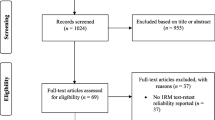Abstract
The relationships of EMG and muscle force with elbow joint angle were investigated for muscle modelling purposes. Eight subjects had their arms fixed in an isometric elbow jig where the biceps brachii was electrically stimulated (30 Hz) and also in maximum voluntary contraction (MVC). Biceps EMG and elbow torque transduced at the wrist were recorded at 0.175 rad intervals through 1.75 rad of elbow extension. The results revealed that while the torque-length relationship displayed the classic inverted “U” pattern in both evoked and MVC conditions, the force-length relationship displayed a monotonically increasing pattern. Analyses of variance of the EMG data showed that there were no significant changes in the EMG amplitudes for the different joint angles during evoked or voluntary contractions. The result also showed that electrical stimulation can effectively isolated the torque-angle and force-length relationships of the biceps brachii and that the myoelectric signal during isometric contraction is uniform regardless of the length of the muscle or the joint angle.
Similar content being viewed by others

References
Amis AA, Dowson D, Wright V (1979) Muscle strengths and musculo-skeletal geometry of the upper lib. Eng Med 8:41–48
An KN, Hui FC, Morrey BF, Linscheid RE, Chao EY (1981) Muscles across the elbow joint: a biomechanical analysis. J Biomech 12:775–788
Brownstein BA, Lamb RL, Mangine RE (1985) Quadriceps torque and integrated electromyography. J Orthop Sports Phys Ther 6:309–314
Dowling JJ (1987) The prediction of force in individual muscles crossing and human elboe joint. Ph.D thesis, University of Waterloo, Ontario, Canada
Dowling JJ, McGuire K (1989) The removal of electrical stimulation artifact from surface EMG. J Biomech 22: 1009
Gordon AM, Huxley AF, Julian FJ (1966) The variation in isometric tension with sarcromere length in vertebrate muscle fibres. J Physiol (Lond) 184:170–192
Gorman PH, Mortimer IT (1983) The effect of stimulus parameters on the recuriment characteristics of direct nerve stimulation. IEEE Trans Biomed Eng 30:407–414
Grabiner M, Robertson RN, Cambell KR (1988). Effects of fatigue on activation profiles and relative torque contribution of elbow flexor synergists. Med Sci Sports Exerc 20:79–84
Guimaraes AC, Herzog W, Anton MG, Carter-Erdman KA (1990) Differences in moment-length relations of rectus femoris muscles of speed skaters/ cyclists and runners. In: Proceedings of the sixth biennial conference of the Canadian Society for Biomechanics. Quebec, Canada, pp 145–146
Hatze H (1981) Estimation of myodynamic parameter values from observations on isometrically contracting muscle groups. Eur J Appl Physiol 46:325–338
Herzog W, ter Keurs HEDJ (1988a) A method for the determination of the force-length relation of selected in vivo human skeletal muscles. Eur J Physiol 411:637–641
Herzog W, ter Keurs HEDJ (1988b) Force-length relation of in-vivo human rectus femoris muscles. Eur J Physiol 411:642–647
Howard JD, Hoit JD, Enoka RM, Hasan Z (1986) Relative activation of two human elbow flexors under isometric conditions: a cautionary note concerning flexor equivalence. Exp Brain Res 62:199–202
Ismail HM, Ranatunga KW (1978) Isometric tension development in a human skeletal muscle in relation to its working range of movement: the length-tension relation of biceps brachii muscle. Exp Neurol 62:595–604
Knaflitz M, Merletti, R, Deluca CJ (1990) Inference of motor unit recuriment order in volunary and electrically elicitated contractions. J Appl Physiol 68:1657–1667
Kulig K, Andrews JG, Hay JG (1984) Human strength curves. Exerc Sport Sci Rev 12:417–466
Leiber RE, Boakes JL (1988) Sarcomere length and joint kinematics during torque production in frog hindlimb. Am J Physiol 254: C759-C768
Rack PMH, Westbury DR (1969) The effects of length and stimulus rate on tension in the cat soleus muscle. J Physiol (Lond) 204:433–460
Soderberg BE, Cook TM (1984) Electromyography in biomechanics. Phys Ther 64:1813–1820
ter Keurs HEDJ, Iwazumi T, Pollack GH (1978) The sarcomere length-tenstion relation in skeletal muscle. J Gen Physiol 72:565–592
Thomson DB, Chapman AE (1988) The mechanical response of active human muscle during the after stretch. Eur J Appl Physiol 57:691–697
Vigreux B, Cnockaert JC, Pertuzon E (1979) Factors influencing quantified surface EMGs. Eur J Appl Physiol 41:119–129
Vredenbergt J, Rau G (1973) Surface electromyography in relation to force, muscle length and endurance. In: Desmedt JE (ed) New developments in electromyography and clinical neurophysiology, vol 1. Basil, Switzerland: S. Karger AG, pp 607–622
Wilkie Dr (1950) The relation between force and velocity in human muscle. J Physiol (Lond) 110:249–280
Author information
Authors and Affiliations
Rights and permissions
About this article
Cite this article
Leedham, J.S., Dowling, J.J. Force-length, torque-angle and EMG-joint angle relationships of the human in vivo biceps brachii. Europ. J. Appl. Physiol. 70, 421–426 (1995). https://doi.org/10.1007/BF00618493
Accepted:
Issue Date:
DOI: https://doi.org/10.1007/BF00618493



